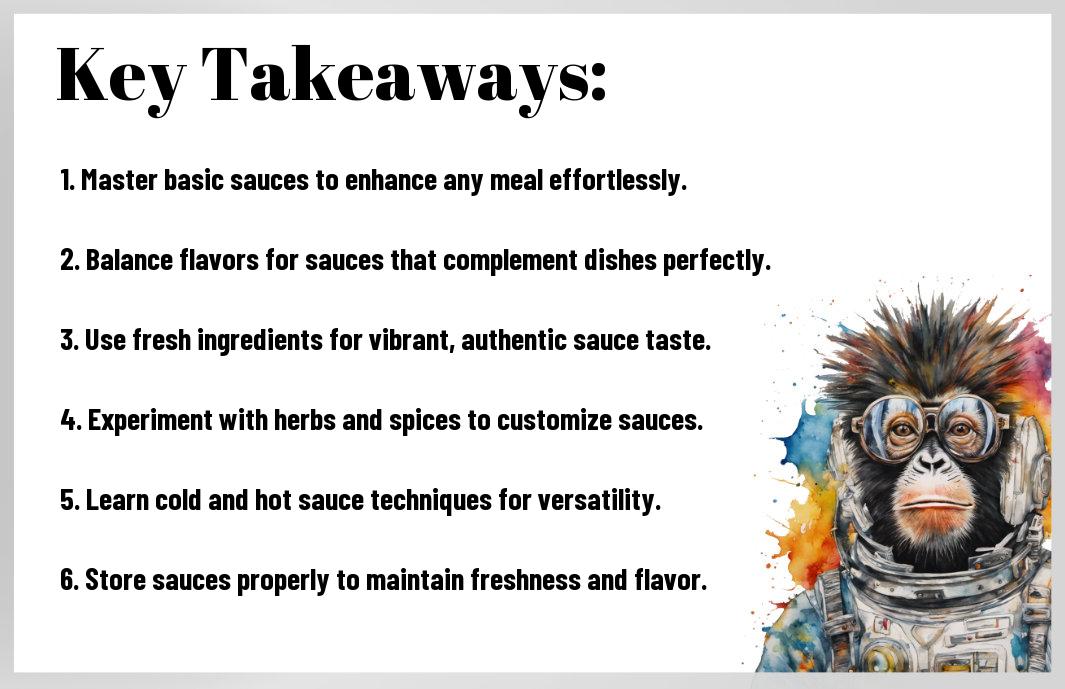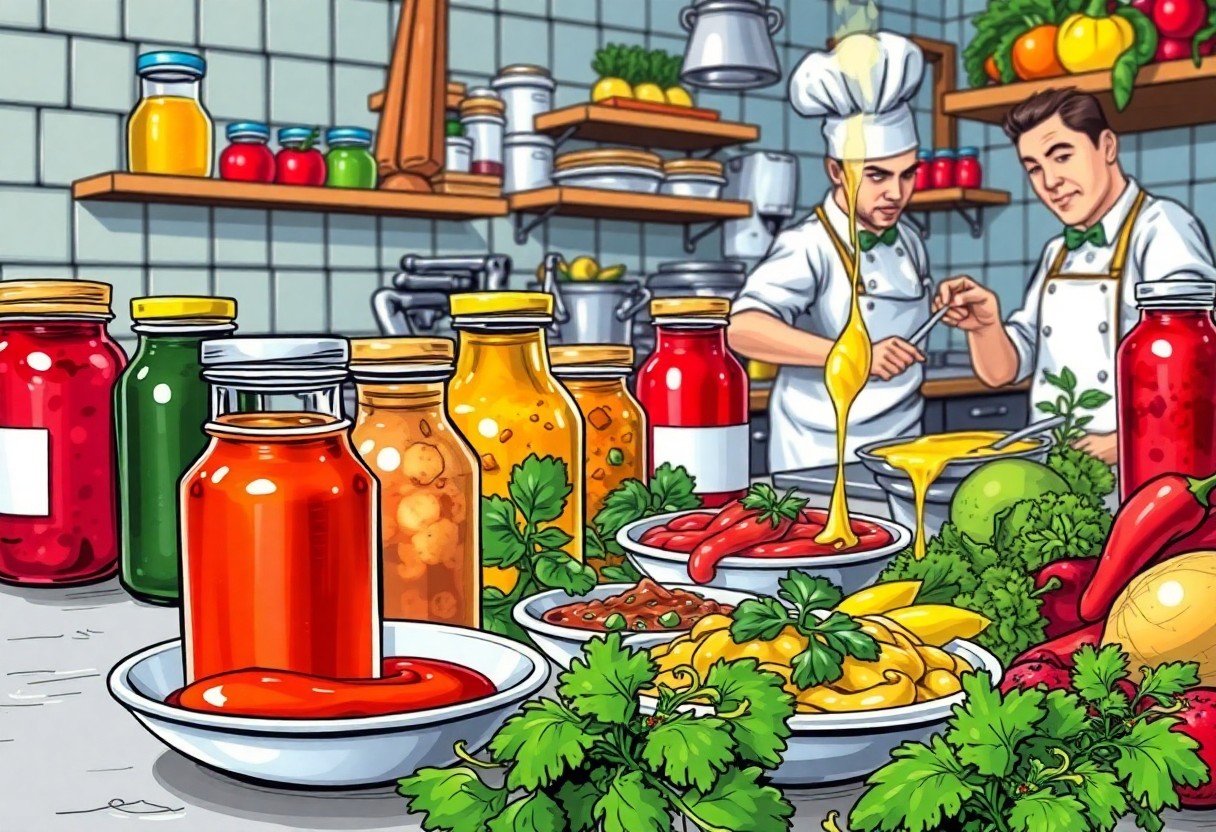There’s nothing quite like a well-made sauce to transform your meals from ordinary to exceptional. By mastering a few important sauce recipes, you can enhance flavors, add depth, and bring your dishes to life in ways you might never have imagined. Whether you’re preparing a simple weeknight dinner or hosting a special occasion, these sauces will give you the confidence and culinary edge to impress everyone at your table. Let’s explore how you can elevate your cooking with these versatile, easy-to-make sauces that suit a variety of tastes and cuisines.
Key Takeaways:
- Mastering a variety of imperative sauce recipes can significantly enhance the flavor and presentation of your dishes.
- Understanding the balance of ingredients and techniques in sauce preparation allows for customization and creativity in cooking.
- Incorporating these versatile sauces into your meals can elevate everyday dishes into impressive culinary experiences.
Transform Your Palate with Classic Sauces
Diving into classic sauces like tomato and béchamel will radically broaden your culinary horizons. These foundational recipes elevate everyday meals and open possibilities for countless variations. By mastering their textures and balancing layers of flavor, your dishes gain depth and authenticity unmatched by shortcuts or pre-made options. Each sauce carries a unique story and technique, rewarding you with nuanced taste profiles every time you cook.
Mastering the Art of Tomato Sauce
Your homemade tomato sauce starts with simmering ripe tomatoes, garlic, and onions until they meld into a rich, vibrant base. Incorporate fresh herbs like basil or oregano to enhance aroma, while balancing acidity with a hint of sugar. Achieve a silky texture by cooking slowly and stirring occasionally, preventing bitterness and ensuring concentrated flavor perfect for pasta, pizza, or braised dishes.
The Versatile Allure of Béchamel
Béchamel sauce serves as a velvety foundation for countless recipes, from creamy gratins to delicate soufflés. Achieving a smooth blend of butter, flour, and warm milk requires patience and steady stirring to avoid lumps while building a luxuriously thick consistency. Season lightly, so it complements rather than overwhelms other ingredients.
Exploring béchamel further, you can transform this simple sauce by infusing it with nutmeg, bay leaves, or even cheese such as Gruyère for a Mornay variation, giving you endless opportunities to customize flavors. Its neutral base makes it ideal for blending with additional spices or integrating into layered dishes like lasagna, where it adds moisture and richness without overpowering the main components. Mastery over béchamel means control over texture and flavor balance, empowering you to enhance both classic and innovative recipes seamlessly.

Bold Flavors: Crafting Sauces with a Twist
Elevate your dishes by experimenting with sauces that introduce unexpected zest and complexity. You can infuse traditional recipes with bold herbs, spices, or unique ingredients that transform each bite into an adventurous experience. These twists invite you beyond the basics, enhancing your meals with layers of flavor that surprise and delight. Embrace the opportunity to pair your proteins and veggies with vibrant sauces that challenge your taste buds and showcase your culinary creativity.
Creating a Zesty Chimichurri
Chimichurri brings a vibrant punch from fresh parsley, garlic, and a generous splash of vinegar, balanced by olive oil’s smoothness. As a sauce rooted in Argentine tradition, it complements grilled meats beautifully but also shines on roasted vegetables or as a marinade. Feel free to amp up the heat with red pepper flakes or add a citrus twist for extra brightness, making this versatile sauce a staple that livens up your kitchen experiments.
The Intriguing Profile of a Peanut Sauce
Peanut sauce offers a rich yet complex balance of nutty sweetness, tang, and subtle heat, typically crafted from peanut butter, soy sauce, lime juice, and chili. Its creamy texture and layered flavor make it ideal for drizzling over grilled chicken, noodles, or as a dip for fresh spring rolls. Adapting this sauce with coconut milk or ginger can transport it into different culinary realms, from Southeast Asian street food to your home-cooked feasts.
Diving deeper into peanut sauce, its strength lies in its adaptability and depth. The interplay between sweet and savory notes creates a satisfying umami hit, while ingredients like tamarind or fish sauce introduce acidity and complexity. You can easily tweak its consistency—from dipping sauce thickness to a pouring glaze—perfecting the balance to suit various dishes. The sauce’s bold, comforting profile not only enhances simple meals but also stands up beautifully against strong flavors, proving indispensable in your sauce repertoire.

Sauces That Steal the Show
Mastering sauces that captivate attention elevates your dishes from good to unforgettable. Take a red wine reduction, for instance—a rich, glossy sauce that harmonizes beautifully with steak or lamb, concentrating flavors through slow simmering. Or consider the vibrant kick of sriracha aioli, transforming mundane sandwiches or grilled seafood with spicy creaminess. These standout sauces don’t just complement your meal; they become the centerpiece, showcasing your skill and taste. Explore how these show-stealers can turn everyday ingredients into culinary triumphs, making your cooking not only flavorful but truly memorable.
Unleashing the Power of a Red Wine Reduction
Simmering red wine with shallots, herbs, and stock creates a sauce bursting with depth and elegance. The gentle reduction process intensifies flavors and thickens the liquid, producing a glossy finish perfect for grilled meats. By controlling the wine’s acidity and sweetness, you tailor the sauce to your dish, balancing boldness and subtlety. This technique transforms simple proteins into gourmet experiences, giving your meals an upscale touch without complex ingredients, making it a valuable skill in your sauce arsenal.
Spicy Secrets of Sriracha Aioli
Sriracha aioli combines the creamy richness of mayonnaise with the sharp, garlicky heat of sriracha, offering a versatile sauce that instantly enlivens burgers, fries, and seafood. Crafting it at home allows you to adjust the spice level exactly to your preference, blending in lime juice or herbs for added brightness. This vibrant, spicy aioli injects personality into your dishes, providing a smooth yet fiery contrast that piques the palate and invites second helpings.
Going deeper, sriracha aioli stands out for its balance between creaminess and spice. Homemade versions often start with fresh garlic mashed into mayonnaise before swirling in sriracha, enhancing both flavor and texture. Adding a touch of lemon or lime juice cuts through the richness, refreshing your palate. This sauce isn’t just for heat lovers; its complex layering of flavors complements a variety of dishes, from crispy chicken sandwiches to roasted vegetables, making it an indispensable component for anyone looking to add bold, dynamic flair to everyday meals.
Health-Conscious yet Delicious: Nutrient-Rich Sauces
Incorporating sauces that boost nutrition without sacrificing flavor can transform everyday meals into nourishing experiences. Using ingredients like fresh herbs, healthy fats, and superfood additions, you’ll find ways to enrich dishes with vitamins and antioxidants. These nutrient-dense sauces not only bring vibrant taste but support your well-being, making each bite both indulgent and beneficial.
Avocado Sauce: Creaminess with a Healthy Spin
Avocado sauce offers a luscious, creamy texture packed with heart-healthy monounsaturated fats, fiber, and vitamins E and C. Blending ripe avocado with lime juice, garlic, and a pinch of chili creates a versatile sauce that complements grilled proteins, roasted veggies, or grain bowls. You’ll love the boost in nutrients without the heaviness of traditional cream-based sauces.
Citrus-Based Dressings for Freshness and Flavor
Citrus-based dressings infuse brightness and zest using grapefruit, lemon, or orange juices combined with olive oil and herbs. These dressings bring refreshing acidity that elevates salads and seafood, while delivering an antioxidant-rich punch that supports immune health and digestion.
Drawing from ingredients like lemon or orange peel adds an extra layer of complexity beyond juice alone, enhancing flavor depth. You can easily customize these dressings by varying sweeteners—like honey or maple syrup—to balance tartness, or incorporating spicy elements such as fresh ginger or chili flakes. Citrus-based dressings not only invigorate your palate but also contribute vitamin C levels that aid in collagen formation and iron absorption, making your meals both tastier and more nourishing.
Elevating Everyday Dishes with Professional Techniques
Integrating professional sauce techniques into your cooking transforms simple meals into extraordinary experiences. Layering flavors, adjusting acidity, and balancing sweetness can turn an ordinary chicken breast or roasted vegetables into restaurant-quality dishes. Using methods like reduction to concentrate flavors or emulsification for creamy textures adds depth and complexity, impressing even seasoned palates. Experiment with these approaches to refresh your regular recipes and create signature meals that showcase your culinary skill.
Combining Sauces for Unique Flavor Profiles
Blending sauces, such as mixing a zesty chimichurri with a smoky barbecue, unlocks inventive flavor combinations that excite your taste buds. This fusion elevates your dishes by introducing new dimensions of taste and aroma. You can balance acidity, sweetness, and heat by pairing complementary sauces, customizing profiles suited to your menu or mood. Any experimentation with sauce pairings encourages creativity and allows you to develop personalized signatures in your cooking repertoire.
Temperature and Timing: The Critical Sauce Factors
Monitoring temperature and timing carefully determines your sauce’s texture and flavor development. Overheating can cause separation, while insufficient simmering may leave flavors unmerged, especially in emulsified or reduction sauces. Knowing the ideal heat level and cooking duration for each sauce type ensures optimal viscosity and taste. Any misstep here alters the sauce’s character, turning a perfect dish into a bland or broken one.
Temperature and Timing: Key Considerations
| Temperature Range | Impact on Sauce |
|---|---|
| Low (120–140°F / 49–60°C) | Preserves delicate flavors; ideal for emulsions like hollandaise |
| Medium (160–190°F / 71–88°C) | Promotes reduction and thickening; perfect for pan sauces |
| High (210°F+ / 99°C+) | Risk of burning and separation; suitable only for initial searing |
Extending cooking time at moderate heat intensifies flavors as water evaporates, concentrating the sauce without jeopardizing texture. Quick cooking at high temperatures often results in burnt or bitter notes that can overpower your dish. Any controlled approach to heat application preserves the integrity of ingredients and enriches your final creation.
Timing Best Practices
| Sauce Type | Optimal Cooking Time |
|---|---|
| Vinaigrettes | Immediate use or chill; no cooking required |
| Reduction Sauces | 10–20 minutes to thicken and intensify |
| Emulsified Sauces | 5–10 minutes at low heat to stabilize |
To wrap up
Taking this into account, mastering Savvy Sauces allows you to effortlessly elevate your dishes, transforming simple meals into extraordinary culinary experiences. By incorporating these important sauce recipes into your cooking repertoire, you enhance flavors and add depth to your creations. With practice, your confidence in the kitchen will grow, enabling you to personalize each sauce to perfectly suit your taste and occasion. Embrace these techniques, and watch as your dishes gain a new level of sophistication and appeal that impresses both family and guests alike.
FAQ
Q: What basic sauces should I start with to enhance my home cooking?
A: Starting with foundational sauces like marinara, béchamel, and mustard vinaigrette can greatly elevate your dishes. Marinara adds a rich tomato flavor perfect for pastas and meats, béchamel provides a creamy base for casseroles and gratins, and mustard vinaigrette offers a tangy touch ideal for salads and roasted vegetables. Mastering these can open doors to countless variations and elevate everyday meals.
Q: How can I adapt sauce recipes to suit different dietary needs?
A: Sauces are versatile and can be modified to accommodate dietary preferences or restrictions. For dairy-free needs, substitute butter and cream with plant-based alternatives like coconut milk or olive oil. For low-sodium options, reduce added salt and enhance flavor with fresh herbs, spices, or a splash of citrus. Experimenting with these adjustments keeps sauces flavorful and inclusive for various diets.
Q: What tips can help me achieve the perfect sauce consistency?
A: Achieving ideal sauce consistency involves controlling heat, cooking time, and thickening agents. Use gentle simmering to prevent separation or burning. Incorporate ingredients like flour, cornstarch, or reduction techniques to thicken sauces as needed. Stir frequently and taste regularly to balance texture and flavor, ensuring your sauce complements the dish seamlessly.


Leave a Reply